
Roanoke College is a private liberal arts college in Salem, Virginia. It has approximately 2,000 students who represent approximately 40 states and 30 countries. The college offers 35 majors, 57 minors and concentrations, and pre-professional programs. Roanoke awards bachelor's degrees in arts, science, and business administration and is one of 280 colleges with a chapter of the Phi Beta Kappa honor society.

Courtland is an incorporated town in Southampton County, Virginia, United States. It is the county seat of Southampton County.

The Virginian Railway Passenger Station, also known as the Virginian Station is a former rail station listed on the National Register of Historic Places in the South Jefferson neighborhood of the independent city of Roanoke, Virginia, U.S.A. Located at the intersection of Jefferson Street SE and Williamson Road, the Virginian Station served as a passenger station for the Virginian Railway between 1910 and 1956. The station was the only station constructed with brick along the entire length of the Virginian's 608 miles (978 km) network. It was severely damaged by fire on January 29, 2001.

Downtown is the central business district of Roanoke, Virginia, United States. Developed after the completion of the Shenandoah Valley Railroad in 1882, the Downtown core forms the geographic center of the city and the center of business for the Roanoke Valley and Southwest Virginia, the Roanoke City Market, the Roanoke Downtown Historic District and many other attractions and amenities.
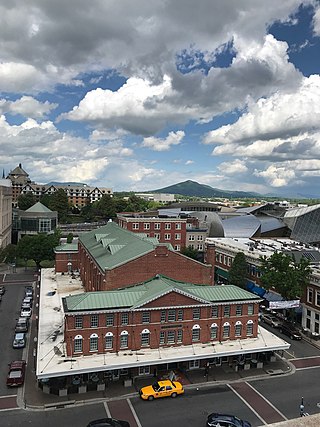
Roanoke City Market Historic District, also known as City Market District, is a national historic district located in the Downtown Roanoke area of Roanoke, Virginia.

Lone Oaks, also known as the Benjamin Deyerle Place and Winsmere, is a Greek Revival mansion listed on both the National Register of Historic Places and the Virginia Landmarks Register in the Greater Deyerle neighborhood of the independent city of Roanoke, Virginia. Located at 3402 Grandin Road Extension SW, Lone Oaks was completed in 1850 as the private residence of Benjamin Deyerle overlooking Mudlick Creek. Today the home still stands, with the surrounding area now developed as single family home typical of those built during the 1970s–1980s. Today the home remains as a private residence. The house is L-shaped with a single pediment Doric entrance portico, which has plain square pillars and fluted columns. It became a Virginia Historic Landmark and was listed on the National Register of Historic Places in 1973.
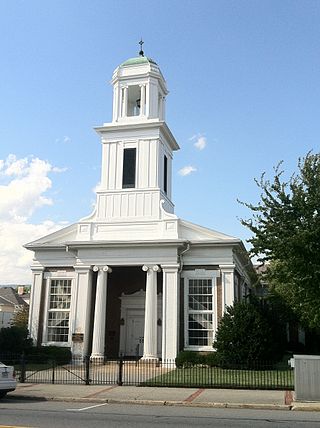
Salem Presbyterian Church is a historic Presbyterian church at E. Main and Market Streets in Salem, Virginia. It was built in 1851–1852, and is a Greek Revival style temple form church. It has a slightly projecting Ionic order portico in antis with belfry. The church owned the Salem Presbyterian Parsonage from 1854 to 1941.
Pleasant Grove, also known as Joseph Deyerle House, Deyerle Homeplace, and Glenvar is a historic home located near Salem in Roanoke County, Virginia. It was built in 1853, and is a two-story, three-bay, Greek Revival style brick dwelling. The front facade features a well-proportioned Ionic order portico with slender tapered, fluted columns. It also has an original sunroom measuring 7 feet by 14 feet. Also on the property are the contributing kitchen, spring house, smokehouse, servant's house, and privy.

The Boxley Building is a historic commercial building located in Roanoke, Virginia. It was built in 1922, during a wave of post-World War I construction in the city. The building is eight stories, and follows a pattern set by other skyscrapers of the time in consisting of three sections similar to a classical column. The bottom section, or pedestal, is one story fronted with granite; the middle section, or shaft, consists of the next six stories built with beige enameled brick; the top section, or capital, is the eighth story fronted with richly decorated terra cotta panels topped with a finely detailed copper cornice.
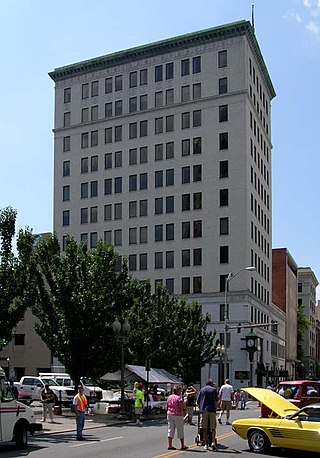
Colonial National Bank, also known as the Colonial-American National Bank and the Colonial Arms Building, is a historic bank and office building located at Roanoke, Virginia. It was built in 1926–1927, and is a 12-story, granite and gray-enamel brick building in the Neoclassical style. The building's design echoes that of a classical column; its first three stories compose the base, its shaft is composed of the next seven stories of unornamented brick, and the top two stories of ornamented brick are the capital. The building has a three-story annex built in two stages in 1949 and 1959. The structure was Roanoke's tallest building for almost fifty years.

St. John's Episcopal Church is a historic Episcopal church in Roanoke, Virginia, United States. It was built in 1891–1892, and is a Gothic style limestone church designed by Charles M. Burns of Philadelphia. The building is a nave-plan, clerestory-style church that includes a corner bell tower and a narthex and chapel in the rear. A Tudor Revival style parish house was constructed in 1923. The church's congregation is one of the city's oldest, and has included many prominent local, state, and national leaders. The church was listed on the National Register of Historic Places in 1991.

Harrison School is a historic public school building for African-American students in Roanoke, Virginia. It is a rectangular, 13-bay brick building done in modified Georgian Revival architecture. The school was built in 1916, and two-story wings were added in 1922. It was the first school in the city to educate black students beyond the seventh-grade level, and its first principal was the noted educator Lucy Addison. After closing as a school in the 1960s, the building served as a child care center and later low-income housing as well as the home of the Harrison Museum of African American Culture.

Norfolk and Western Railway Company Historic District is a national historic district located in Roanoke, Virginia. It encompasses three contributing buildings constructed by the Norfolk and Western Railway (N&W). They are the Neoclassical Revival style General Office Building–South ; the Art Deco period General Office Building–North (1931); and the Moderne style Passenger Station.

The Gainsboro Branch Library is a historic library building located in the Gainsboro neighborhood of Roanoke, Virginia, United States. It was built in 1941–1942 and is a one-story, seven-bay brick building built with an L-plan and gabled roof, and designed in the Tudor Revival style. The library's history dates to 1921 as the fourth established African American library in the Southern United States. It is home to a significant Black history collection that was gradually amassed by longtime librarian Virginia Lee. After being told by city officials to remove the items, Lee hid them instead and kept them available for patrons. The collection is now on display in a room dedicated for and named after Lee, and the library has seen recognition for its role in preserving the area's African American heritage.

The Crystal Spring Steam Pumping Station is a historic pumping station located at Roanoke, Virginia, in the United States. It was built in 1905, and is a one-story building constructed in common-bond brick. The building houses a Corliss-type pump made by the Snow Steam Pump Company in Buffalo, New York. At its peak, the pump provided 5,000,000 US gallons (19,000 m3) of water daily. It was in operation from 1905 to 1957, and was an important source of fresh water in Roanoke's early history.
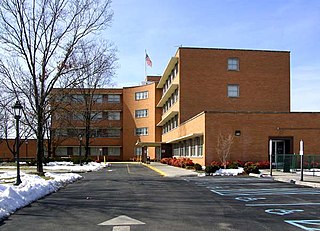
Burrell Memorial Hospital, currently operating as Blue Ridge Behavioral Health (BRBH) Burrell Center, was an historic African-American hospital originally located in the Gainsboro neighborhood of Roanoke, Virginia. The hospital replaced the 1914 Medley Hospital. It opened March 18, 1915 as a 10-bed facility in a converted home at 311 Henry Street. In 1921 the hospital moved to a new, 55-bed location in the adjacent Harrison Neighborhood, having renovated the former Allegheny Institute at 611 McDowell Ave., NW. The final facility was constructed 1954-55 on the same property as a four-story, 73,000 square foot, International Style building. It is T-shaped with three wings extending from a central elevator core. The building housed the only African-American medical facility in Roanoke from 1915 to 1965. It was listed on the National Register of Historic Places in 2003. Burrell Memorial Hospital closed in 1979 due to financial strain and reopened the same year as the Burrell Home for Adults, an adult care facility. This facility grew to provide specialized care to residents, but eventually closed as Burrell Nursing Center in 2002.
First Baptist Church was a historic African-American Baptist church located in the Gainsboro neighborhood of Roanoke, Virginia. It was built in 1898–1900, and was a large six-bay nave-plan brick church with Romanesque and Gothic detailing. It featured a clipped gable roof and a front bell tower. A one-story Parish Hall was built in 1936. First Baptist Church occupied the building until moving to a new sanctuary in 1982. The church was destroyed by fire in April 1995.
Gustave A. Sedon, also known as Gustavus Sedon, was a carpenter and craftsman in nineteenth century Roanoke, Virginia. He is noted for his work on various public buildings, plantation homes, and university structures. Sedon is known primarily for his ornamental work on buildings, many of which are now listed on the National Register of Historic Places.
Benjamin Deyerle (1806–1883) was an architect, artist and brickmaker in Roanoke County, Virginia. Many of the historic homes, churches and public buildings in Roanoke were designed and built under his and his family's direction. He is credited with building 23 of them, and perhaps more. Some of these homes and buildings are currently listed on both the National Register of Historic Places and the Virginia Landmarks Register.
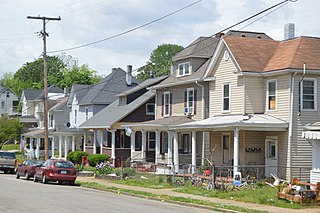
The Belmont Historic District is located in the southeast section of Roanoke, Virginia, US. It consists of an irregularly-shaped 214 acres (87 ha) of primarily residential housing located to the east of the city's downtown and south of the Roanoke Shops.




















